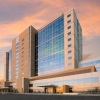Specialization is driving the hospital bed market
by Jennifer Rioux, Contributing Reporter | April 12, 2016

The design and functionality of hospital beds are not only pivotal to facilitating staff workflow and patient care, they are critical elements influencing patient satisfaction in hospital environments.To get an overview of the industry, HealthCare Business News spoke with ECRI’s Mairead Smith, project officer in the Medical Device Evaluation Program. She notes that bed technology has changed incrementally in the past few years with improved mobility, powered transport, fifth wheels, nurse calls and scales — and recently, a trend toward “smart bed” technology.
Smith cautions hospitals to consider which bells and whistles will provide the most functionality and value. The unit price for beds averages $25,000 across all categories, including reconditioned beds. Higher-priced beds are being purchased for specific uses or features, including intensive care, bed exit alarms or specialty mattresses. She said that “smart bed” manufacturers are promoting new technology, but hospitals are not always using it because they don’t know what to do with the data. For instance, many manufacturers have their own nurse call system, and having another source of alarms can cause complications like alarm fatigue, where staff attention is reduced due to competing stimuli.
Smith points out that “hospitals do not want to spend money on functions they don’t need.” Smith offers some advice to purchasers:
• Make decisions about the bed frame and surface separately, because surfaces may be replaced several times.
• Training is an important feature — whether it is included or additional is something the hospital should look into.
• Service and response times are also important: how many maintenance treatments do you get per year? She recommends clarifying all the terms before committing. Some functions to consider when hospitals are looking at bed purchases include: moving the bed; stand assist technology; frame-based solutions for minimizing repositioning, reducing strain on patients and staff; integrated nurse call; patient movement and patient weight tracking; bed exit alarms; and EMR interfacing.
Mutifunctionality versus tailored special-use beds
Mary Nell Westbrook,executive vice president and chief marketing officer from Sizewize, believes, “it’s all about making a bed that treats the patient like a guest in a hotel, while at the same time making a bed that’s affordable for the facility.”
When it comes to functionality, Colin Bain, CEO of LINET, notes that their beds offer special features such as “patient mobilization and frame-based lateral tilt to help caregivers safely turn patients. Standard features, which include an in-bed scale, an automatic braking system, a multi-zone bed exit alarm, hands-free foot controls and an integrated X-ray cassette tray, help staff meet critical care demands within today’s budget.”
Smith cautions hospitals to consider which bells and whistles will provide the most functionality and value. The unit price for beds averages $25,000 across all categories, including reconditioned beds. Higher-priced beds are being purchased for specific uses or features, including intensive care, bed exit alarms or specialty mattresses. She said that “smart bed” manufacturers are promoting new technology, but hospitals are not always using it because they don’t know what to do with the data. For instance, many manufacturers have their own nurse call system, and having another source of alarms can cause complications like alarm fatigue, where staff attention is reduced due to competing stimuli.
Smith points out that “hospitals do not want to spend money on functions they don’t need.” Smith offers some advice to purchasers:
• Make decisions about the bed frame and surface separately, because surfaces may be replaced several times.
• Training is an important feature — whether it is included or additional is something the hospital should look into.
• Service and response times are also important: how many maintenance treatments do you get per year? She recommends clarifying all the terms before committing. Some functions to consider when hospitals are looking at bed purchases include: moving the bed; stand assist technology; frame-based solutions for minimizing repositioning, reducing strain on patients and staff; integrated nurse call; patient movement and patient weight tracking; bed exit alarms; and EMR interfacing.
Mutifunctionality versus tailored special-use beds
Mary Nell Westbrook,executive vice president and chief marketing officer from Sizewize, believes, “it’s all about making a bed that treats the patient like a guest in a hotel, while at the same time making a bed that’s affordable for the facility.”
When it comes to functionality, Colin Bain, CEO of LINET, notes that their beds offer special features such as “patient mobilization and frame-based lateral tilt to help caregivers safely turn patients. Standard features, which include an in-bed scale, an automatic braking system, a multi-zone bed exit alarm, hands-free foot controls and an integrated X-ray cassette tray, help staff meet critical care demands within today’s budget.”
You Must Be Logged In To Post A CommentRegisterRegistration is Free and Easy. Enjoy the benefits of The World's Leading New & Used Medical Equipment Marketplace. Register Now! |
|








